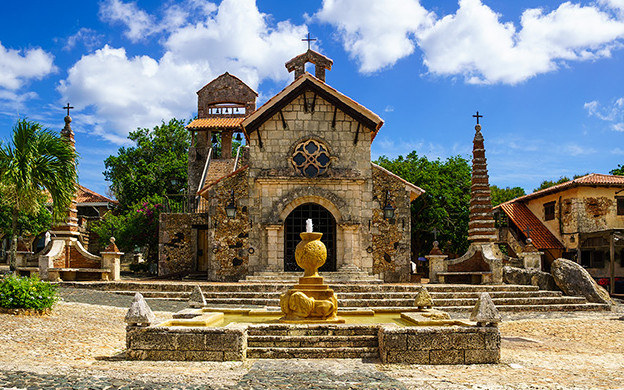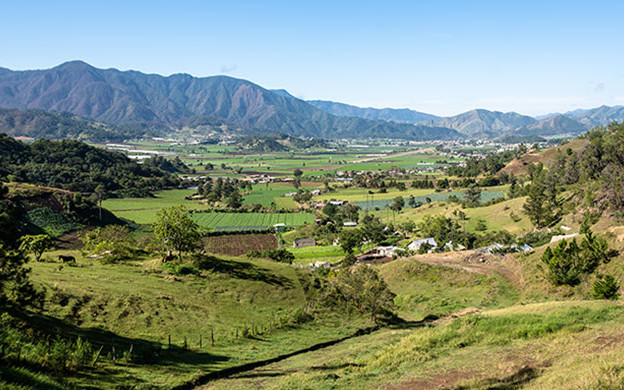Évasion paradisiaque en République dominicaine
Plages dorées et rythmes envoûtants vous attendent.
Vivez la magie des Caraïbes entre mer et culture.
République dominicaine : découvrez le berceau du merengue.
L’île d’Hispaniola, comme l’avaient baptisée jadis les Conquistadors, ne se limite en effet pas uniquement aux stations balnéaires de la côte nord autour de Puerto Plata et Punta Cana et à ses plages de rêve baignant dans les eaux cristallines de la mer des Caraïbes, comme la Playa Bonita ou la Playa Dorada. La République dominicaine, qui partage l’île avec Haïti, c’est aussi une belle diversité de paysages entre collines arides, forêts luxuriantes, cascades rafraîchissantes, massifs montagneux et grands lacs salés comme à Enriquillo pour offrir aux trekkeurs une dizaine de parcs naturels : parc del Este, Los Haitises, José Armando Bermudez, José del Carmen Ramirez…
Voyager en République dominicaine, en couple ou entre amis, en voyage organisé ou en voiture de location pour un autotour, c’est aussi partir à la découverte des petites îles tropicales méconnues qui bordent l’île principale comme l’île Saona ou l'île Catalina pour randonner et partir en plongée. Il serait aussi dommage de rester à la plage et de ne pas visiter au sud la capitale Saint-Domingue et sa zone coloniale inscrite au patrimoine mondial de l’Unesco ou encore les nombreux villages de pêcheurs et leurs maisons colorées comme à Las Terrenas dans la péninsule de Samaná.
Une île aux mille découvertes et plaisirs
Plus de cinq siècles après sa découverte par Christophe Colomb en 1492, la République dominicaine possède assez de facettes et d’atouts pour qu’on la redécouvre à chaque voyage. Située dans les Caraïbes, cette île offre une diversité de paysages allant des plages de sable fin aux montagnes verdoyantes. Elle est également riche en culture, avec une histoire influencée par les cultures taïnos, africaines et européennes. La musique et la danse y occupent une place importante, avec le merengue et la bachata comme symboles nationaux. La République dominicaine est aussi une destination prisée pour ses activités de plein air comme la plongée, le surf ou la randonnée, permettant à chaque visiteur de vivre une expérience unique et inoubliable.

Les incontournables à découvrir
Fondée au début du XVIe siècle, la capitale Saint-Domingue (Santo Domingo en espagnol) est l'une des plus anciennes cités des Caraïbes. Son centre historique, la "Zone coloniale", inscrit au patrimoine de l'Unesco, abrite de nombreux monuments comme la cathédrale Notre-Dame de l'Incantation, l'Alcazar de Colón et la forteresse Ozama.
Sur la côte nord-est, bordée par l'océan Atlantique et la mer des Caraïbes, la péninsule de Samaná est le point de ralliement des baleines à bosse. Elles viennent chaque année mettre bas dans ces parages entre janvier et mars.
Situé en plein cœur du pays, le massif de la Cordillère centrale offre, au milieu des plantations et des villages de montagne, un formidable terrain de jeu pour la randonnée, le VTT ou les descentes en rafting.

Explorer la République Dominicaine autrement
S'envoler en windsurf à Cabarete
Le petit village de pêcheurs de la province de Puerto Plata, sur la côte d’Ambre, est devenu un spot réputé pour le surf et les sports de voile comme le kitesurf et le windsurf. Ce lieu idyllique attire des amateurs du monde entier, venus profiter des conditions exceptionnelles offertes par la nature.
S'offrir un bout de paradis sur l'île Saona
À l'extrémité sud-est de l'île principale, dans la mer des Caraïbes, l'île Saona est un véritable paradis terrestre. Ses plages sauvages de sable fin, bordées de palmiers, ses mangroves, ses récifs de corail et ses tortues composent un décor de rêve.
Se poser à Puerto Plata
Au nord, les environs de Puerto Plata sur la côte d'Ambre offrent la plus grande concentration de plages paradisiaques et d'hôtels de la République dominicaine. De nombreuses stations balnéaires telles que Playa Dorada et Costa Dorada accueillent les visiteurs en quête de détente.
Une douceur de vivre incomparable
Les Dominicains sont d'une gentillesse touchante à laquelle vous succomberez assez vite, à condition d'aller à leur rencontre. La musique, parfois un peu forte pour les oreilles européennes, accompagne la vie quotidienne tout au long de la journée : dans les transports, les marchés, les boutiques et même la nuit. Serviables, les autochtones n'hésiteront pas à s'arrêter si vous vous trouvez en panne au bord de la route. Ils trouveront des solutions ingénieuses pour réparer un pneu crevé ou vous aideront à retrouver votre chemin si vous êtes perdu. On ne manque pas alors de partager une noix de coco, une bière bien fraîche ou un cocktail rehaussé d'un rhum pour mieux se connaître. Musique, alcool, mer et soleil font bon ménage en République dominicaine. Comme nulle part ailleurs, la douceur de vivre s'exprime dans la nonchalance des démarches chaloupées, dans les sourires des visages joliment métissés, et dans l'espièglerie des yeux des enfants.
Un climat idéal toute l'année
La saison hivernale, d'octobre à mars, n'est pas vraiment marquée en République Dominicaine. Le temps y reste très clément avec une température moyenne de 26 °C toute l'année. Les Dominicains portent des pulls pendant cette période, tandis qu'un Européen, habitué aux rigueurs des climats continentaux, se contentera d'un tee-shirt, car chaleur et soleil sont présents ici toute l'année. L'été, de mai à septembre, est particulièrement chaud et humide. La période cyclonique, de juillet à octobre, apporte parfois des pluies très violentes mais de courte durée. Dans le centre montagneux, les températures sont beaucoup plus basses, descendant parfois sous 0 °C au sommet du Pico Duarte, à plus de 3 800 mètres. La région de Jarabacoa est l'une des zones les plus humides d'Hispaniola et possède la plus grande amplitude thermique, de 14 °C en hiver à 30 °C en été.
Le berceau du merengue et de la bachata
La danse occupe une place de choix en République dominicaine, imprégnée d'un mélange de cultures espagnole et africaine. Parmi les nombreux rythmes de danse et de musique, le merengue est le plus prisé. Considérée comme la danse "nationale", elle est reconnue par tous les Dominicains et célèbre dans le monde entier. Depuis novembre 2016, elle est inscrite au patrimoine immatériel de l'UNESCO. L'origine du merengue reste floue : certains disent qu'il vient de la région de Cibao, d'autres des régions frontalières à Haïti, ou encore d'un mélange de danses africaines et du menuet français. Le merengue comporte plusieurs variantes : dans les campagnes avec güira, tambour et accordéon, et dans les villes avec cuivres, piano et chœurs. En juillet, la Semana del Merengue à Santo Domingo est l'occasion de se mêler à la population en dansant dans la rue ou sur la plage. Les chanteurs Sergio Vargas et Johnny Ventura sont des icônes du merengue.
Une explosion de couleurs et de traditions
Le carnaval dominicain est particulièrement animé et coloré. C'est une fête très populaire où se mêlent traditions espagnoles, foi chrétienne et rites africains, remontant au-delà de l'époque coloniale. Le carnaval se décline dans toutes les régions du pays avec des rythmes effrénés et des musiques entêtantes, mettant en scène des diables cornus, des coqs, des taureaux et des caciques. Les participants défilent chaque dimanche de février à travers la République dominicaine.
Le carnaval atteint son paroxysme le 27 février, jour de l'indépendance nationale, et se poursuit dans certaines villes jusqu'en mars. Les plus célèbres sont ceux de La Vega et de Saint-Domingue, mais ceux de San Pedro de Macoris ou de Santiago rivalisent de créativité et d'imagination. Là aussi, les rues se transforment en théâtre improvisé. Des hordes d'enfants costumés matraquent les spectateurs avec des ballons. Des kiosques distribuent le rhum sans compter, tandis que des groupes de musique déchaînent la fougue des danseurs sur des rythmes soutenus. Bref, un carnaval sous le double signe de la satire et de la fête.
A website by
Customize your trips with Quotatrip and receive tailor-made offers directly in your inbox.
Discover a country